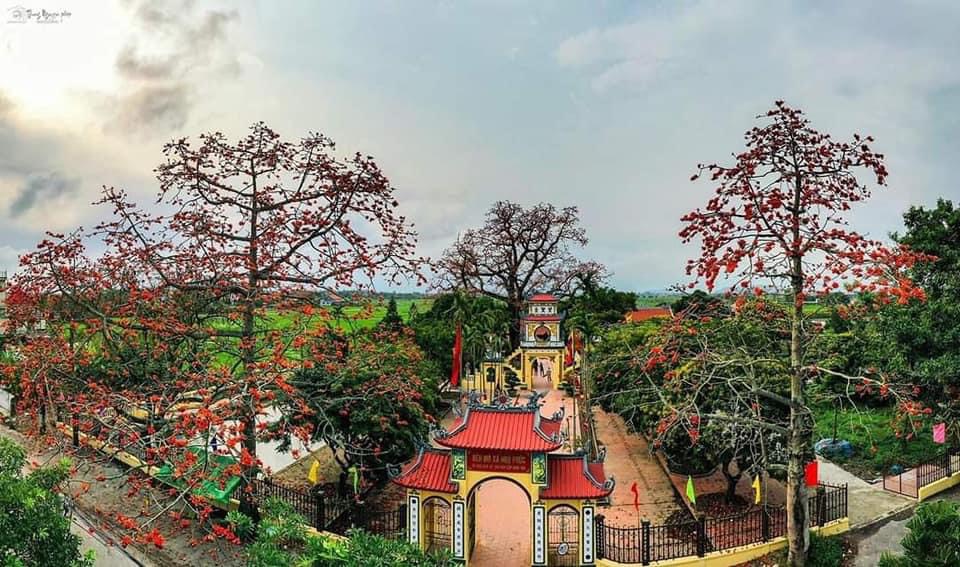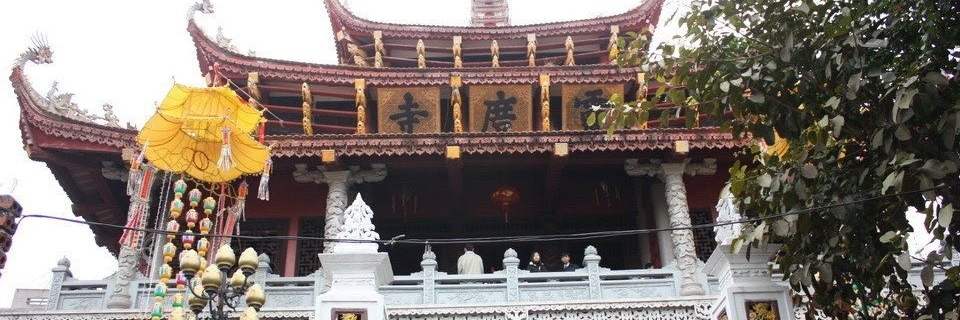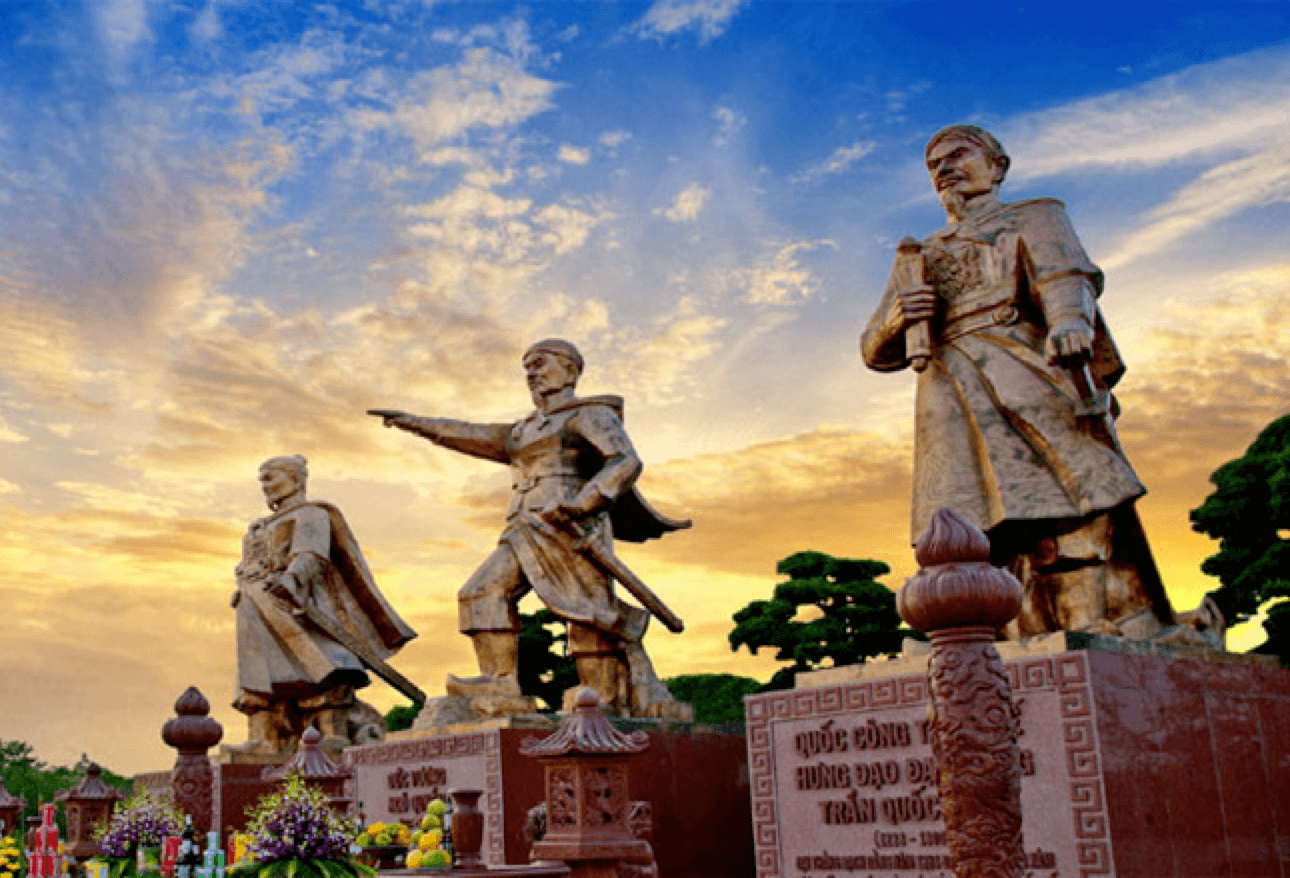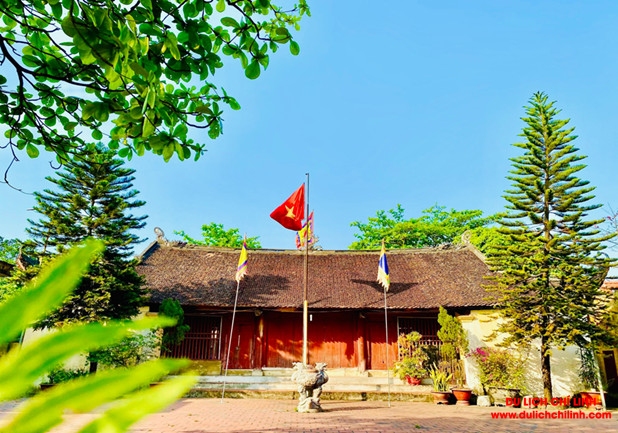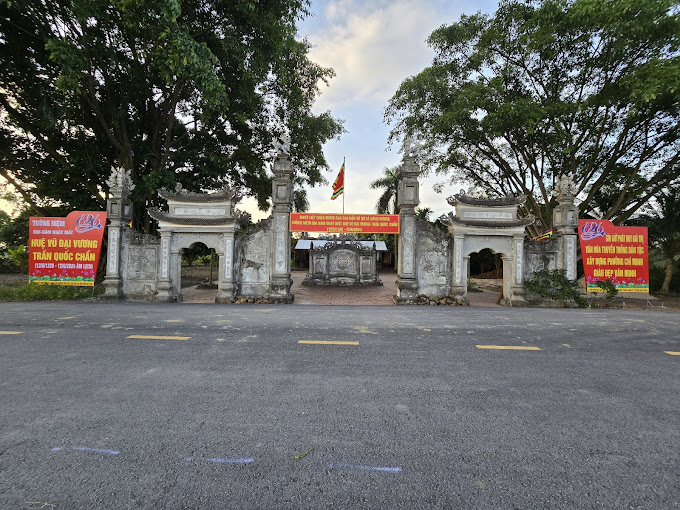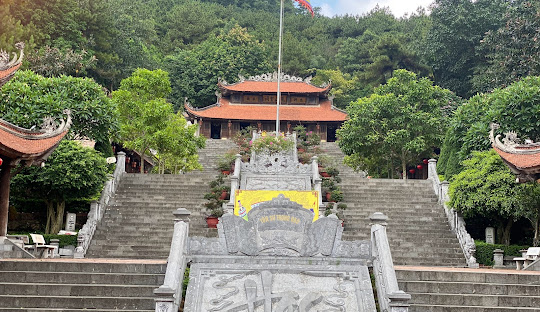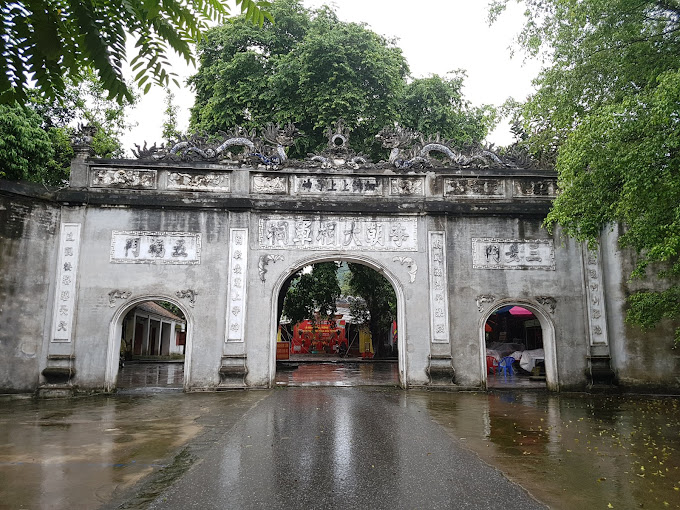Relic point Vietnam
Việt NamTuong Long Tower
Do Son tourist area, Hai Phong is famous for its ideal beaches and charming scenery. But few people know that on top of Long Son (Ngoc Xuyen ward), the first of nine mountains running along Do Son peninsula, there is also a cultural and historical relic thousands of years old - Tuong Long tower. Tuong Long Tower (also known as Do Son Tower) was built during the reign of Ly Thanh Tong. This Buddhist architectural work was built on a land area of about 2,000 m2, located in Van Son ward, Do Son town. The four corners of the tower all lean to the center at 190 degrees. The inside of the tower is hollow and is where the Amitabha statue is placed. The building is built of bricks and stones of different sizes. In addition to bricks, there are also bricks covering the outside of the tower shell with unique decorative arts such as lotus flowers, chrysanthemums, and lemon flowers. This decoration represents typical Ly Dynasty art. According to the book "Dai Viet History", in the year Mau Tuat 1058, King Ly Thanh Tong, after traveling across Ba Lo beach, stopped here to build a tower. Later, he dreamed of a golden dragon and gave the tower the name Tuong Long, meaning "Seeing the golden dragon appear" to remember the good omen. Some people believe that Do Son seaport is one of the cradles that received the tower here to worship Buddha. In the past, this place may have been an observatory in the "transmitting light" system. Whenever there is an incident, coastal observation stations burn dry grass to send smoke into the sky, transmitting alarm signals to the capital. Through the remaining relics, it can be seen that Tuong Long tower was built at the same time as Bao Thien tower in Thang Long citadel (now the Hanoi Opera House area). According to Dai Nam Nhat Thong Chi", the old Do Son tower is 100 meters high, built on a 1000m2 area of land, has 9 floors, the door opens to the west. One meter is 0.45m long, so the tower is about 0.45m high. , located on a mountain 100m above the sea, so this tower was among the tallest towers in Vietnam at that time. Tuong Long Tower was renovated and restored many times during the Tran and dynasties Le, but in the 3rd year of Gia Long (1804), the Nguyen court demolished the tower to get bricks to build Hai Duong citadel. This proves that the ancient Tuong Long tower was extremely large and majestic. From the location of Tuong tower Long can see the sea with ships going out to sea to catch fish to bring back fresh seafood to serve tourists, see Do Son town with villages and green fields, and understand the ancients. Carefully choose the location to build the tower. SOURCE: Hai Phong City Electronic Information Portal
Hai Phong 2792 view
House number 1, lane 42 Me Linh
House No. 1, Alley 42 Me Linh, An Bien Ward, Le Chan District, Hai Phong is a secret agency of the Provincial Committee of the Vietnam Revolutionary Youth Comrades Association of Hai Phong in 1927 - 1929, a secret agency of Indochina Communist Party Committee of Hai Phong Province in the period 1929 - 1930. There was once the base of operations of comrades Nguyen Duc Canh, an elite soldier of the Party, a son of the working class. People and working people of Hai Phong. After attending a political training class organized by comrade Nguyen Ai Quoc in Guangzhou, in September 1927, comrade Nguyen Duc Canh returned home to work and was appointed by the Vietnam Revolutionary Youth Committee as comrades of the Association. Secretary of the Provincial Party Committee of Vietnam Revolutionary Youth Comrades Association of Hai Phong. In early 1928, he implemented proletarianization and opened training classes, wrote newspapers to enlighten the revolutionary masses, and fought against the oppression and exploitation of the French colonialists. In June 1929, the Indochina Communist cell was established. In September 1929, at the above location (1/42 Me Linh), a conference of outstanding communist youth voted to establish the Indochina Communist Party of Hai Phong. After the conference to unify the three Communist Party organizations in Vietnam (February 3, 1930), comrade Nguyen Duc Canh, as Northern Party Committee of Tonkin, returned to consolidate the Hai Phong Party Committee. Thanks to the correct policy of the Central Government, under the direct direction of the Northern Party Committee, the Hai Phong Party Committee was able to mobilize the masses to fight enthusiastically and continuously. In 1929, the Governor of Hai Phong propagandized, distorted and defamed the noble ideals of the communists. Comrade Nguyen Duc Canh wrote an article exposing the colonialist's distorted arguments, and at the same time Through this, we enlighten the masses to clearly see their sinister face and call on the masses to support the communists for the cause of national and class liberation. In this house, there are still some relics (restored) that comrade Nguyen Duc Canh used such as: desk, cabinet, wooden bed. Every year, the house at 1/42 Me Linh is cared for and renovated by the Party Committee and people of Hai Phong. That is the place that marked a period of secret activities of the Party. Comrade Nguyen Duc Canh, an eminent revolutionary soldier of the Party, the first Secretary, a glorious son of the working class and the people of Hai Phong, fell at a very young age. Today, at 124 Nguyen Duc Canh, there is also a memorial plaque for comrades. SOURCE: Hai Phong City Electronic Information Portal
Hai Phong 2654 view
Mo Pagoda Relics
Mo Pagoda Relics - Hai Phong spiritual tourist destination located in Ngu Phuc Commune, Kien Thuy district, Hai Phong city Legend has it that Mo Pagoda worships Princess Quynh Tran, daughter of King Tran Thanh Tong, who also publicized this land when choosing this place to build a pagoda, recruiting people to reclaim land, and build together. build. The pagoda has an ancient beauty, quiet over the years, along with an ancient rice tree that has stood tall for more than 720 years, recognized as a Vietnamese heritage tree. In 1991, Mo Pagoda was recognized as a National Historical and Cultural Monument. SOURCE: VIETNAM NATIONAL TOURISM BUREAU
Hai Phong 2638 view
Red Pagoda relic area
The Red Pagoda relic area is located on Le Lai Street, Ngo Quyen district, Hai Phong city Red Pagoda is the common name of the ancient Linh Do Tu pagoda. The reason the pagoda is named Linh Do is because this is the place that villagers established in the high basin area near the riverbank, with the desire to worship Buddha and pray for Tathagata's salvation for the unfortunate souls drifting to the riverbank here. . According to the people of this place, the Red Pagoda is one of the most sacred pagodas in the city of red poinciana. The pagoda also attracts pilgrims and sightseeing visitors when it possesses ancient architecture with 3 floors, 20 roofs, 26m high - a unique architecture that is unique in the history of pagoda architecture in Vietnam. . SOURCE: VIETNAM NATIONAL TOURISM BUREAU
Hai Phong 2897 view
Bach Dang Giang relic area
Bach Dang Giang relic area in Thuy Nguyen, Hai Phong is 20 hectares wide, located in the Trang Kenh scenic complex recognized in 1962. Those three naval battles were, the battle of Ngo Quyen to defeat the Southern Han army in 938, the battle of Le Hoan to defeat the Song army in 981 and the battle of Tran Quoc Tuan to defeat the Mongol Yuan army in 1288. Great as that, but with remaining legacies is still not enough to show the magnitude of those victories. Recognizing these great values, since 2008, dedicated people have been determined to rebuild the complex that marks the sacred soul of the mountains and rivers of the South. The entrance to the relic is a pebble garden and a stone pillar about 5 meters high, all four sides are engraved with words, the middle side is engraved with the poem "Giang san is prosperous Bach Dang thau", the remaining three sides praise the merits of the three predecessors. in naval battles. The complex has many other areas such as Bach Dang Giang temple worshiping Ngo Quyen Vuong, who founded the Bach Dang stake battle, defeated the Southern Han army in 938, ended 1117 years of Northern domination, and opened Dai Viet civilization. Trang Kenh Vong De Temple worships King Le Dai Hanh, who in 981 recreated the stake of Ngo Quyen to attack Song Binh Chiem, bringing Dai Co Viet on par with Dai Han. The Trang Kenh shrine worships Quoc Cong Tiet Hung Dao Dai Vuong Tran Quoc Tuan, who defeated the Mongol army three times, culminating in the Bach Dang victory in 1288, opening up the brilliant East Asian civilization. All three temples are designed according to ancient architecture with a wonderful combination of wood and natural stone. The Temple of President Ho Chi Minh is the last place in the four sacred words of the Bach Dang Giang relic site. This is the first place in Hai Phong to build a temple to worship President Ho Chi Minh, the great leader of the nation, who is always in the hearts of all Vietnamese people. Truc Lam Temple of Trang Kenh, this is a pagoda modeled after Dong Pagoda in Yen Tu. The pagoda worships Buddha Tathagata, Dama and Bodhisattva, Buddha Emperor Tran Nhan Tong. At the foot of the pagoda are the Bach Ngoc statues of 18 Arhats and an ancient banyan tree over a hundred years old. The pagoda is one of the highest places in the Bach Dang Giang relic area, with a panoramic view of the spacious space, overlooking the Bach Dang river and the majestic Dong Trieu range. Especially on clear days, visitors can also see Yen Tu landscape. The Holy Mother Temple in the relic worships the First Mother of Heaven, the Second Mother of Thuong Ngan, and the Third Mother of Thoai Phu. In the temple there are also incense burners and statues worshiping Ngu Vi Ton Ong, Tam Vi Hoang, Duc Nam Hai Than Vuong and Mau Son Trang. In the relic area, there is also a museum displaying Bach Dang pile artifacts preserved in their original state; diagram of the battles on Bach Dang river; archaeological sites of ceramics from the Le and Tran dynasties..; Vietnamese history through the ages. SOURCE: VIETNAM NATIONAL TOURISM BUREAU
Hai Phong 3201 view
Dinh Chi Linh
Chi Linh communal house is located in Chi Linh village, Nhan Hue commune, Chi Linh city, Hai Duong province. Based on the "Miraculous inscription" engraved in the year Tu Duc 20 (1867) still preserved here, it is said that Chi Linh communal house worships 3 village tutelary gods including: Cao Son Quoc Trang Dai Vuong (ie Cao Hien, Holy Elder); Duong Canh Thanh Hoang Quang Bac Dai Vuong (ie Pham Cuong, Thanh Hai); Duong Canh Thanh Hoang Hung Due Dai Vuong (aka Pham Uy - Thanh Ba) According to legend, Cao Son Quoc Tu Dai Vuong was a member of Tan Vien's family. The second King of the 18th Hung King's reign, Cao Hien, was skilled in literature and martial arts. He "conspired" to help King Ly Thai Tong fight the enemy to save the country. Cao Son Dai Vuong transformed into a talented general of King Ly leading his army to fight the enemy. Arriving at Ba Gia Trang, Nam Sach district, Hai Duong town, I met two twin brothers, villagers Pham Cuong and Pham Uy, the children of Mr. and Mrs. Pham Chan and Dao Thi Quy. Seeing that the two brothers Pham Cuong and Pham Uy were talented in martial arts and martial arts, Hien Cong immediately recruited them to be his generals. After fighting the battle of Ben Dong (now Binh Than - Luc Dau) and returning victorious, through Ba Gia Trang, the army, Hien Cong and two generals Pham Cuong and Pham Uy turned out on the same day. Remembering the gratitude of the three talented generals, King Ly Thai Tong came down to hold a solemn funeral and allowed local people to set up a temple to worship. Chi Linh Communal House was built around the Later Le Dynasty (18th Century), restored and embellished during the Nguyen Dynasty in 1848, 1856, 1859, 1867, 1911. The original architecture was in the style of the letter "Dinh" consisting of 5 Dai Bai compartment and 3 Hau palace compartments are built in the west direction. In the year of Khai Dinh (1916), the people continued to build 5 more worship halls and two dance halls to meet the people's daily needs during festivals. Having gone through many historical upheavals, Chi Linh communal house still preserves many precious antiques such as a set of statues of the "Three Tutelary Gods" from the Nguyen Dynasty, 9 ordinations from the reign of King Thanh Thai to King Khai Dinh, 16 panels. merit stele from the 18th and 19th centuries... The communal house is located on a high and wide mound, in front of the Thai Binh river flowing downstream, behind a series of long ponds and lakes, originally an ancient river branch after many times of filling. The remaining dyke surrounds the monument, forming a natural barrier. Harmonious and breathtaking natural landscape. Chi Linh Communal House is a place to worship heroes associated with the religious life of the people of Nhan Hue commune, molding the nation's patriotic traditions. Chi Linh communal house festival takes place on the 10th day of the 3rd lunar month every year, the festival takes place for 3 days, of which the 10th day is the main festival. Based on its historical value, spiritual culture and traditional architecture, Chi Linh Communal House was ranked National by the Ministry of Culture and Information in 1994. Source Electronic information portal of Chi Linh city, Hai Duong province.
Hai Phong 3270 view
National Father's Temple
Quoc Phu Temple is one of eight relics belonging to the famous "Chi Linh bowl" recorded by many history books. Previously, the temple belonged to Kiet Dac commune, Chi Linh district. Now the relic belongs to Neo village, Chi Minh commune, Chi Linh district, Hai Duong province. This is the temple of the Imperial Father Tran Quoc Chan - one of the outstanding generals of the Tran Dynasty, with impeccable talent and virtue, wholeheartedly devoted to the cause of building and protecting the country. Tran Quoc Chan was the second son of Tran Nhan Tong, younger brother of Crown Prince Tran Thuyen, who later became Tran Anh Tong. He was a political figure, official and prince of the Tran dynasty during the reigns of kings Anh Tong and Minh Tong, considered one of the outstanding political figures and a talented man. But the end of life is full of injustice. Tran Quoc Chan was convicted of treason and starved to death. His death left behind a lot of criticism from historians towards Tran Minh Tong. By the year Giap Than (1341), during the reign of Tran Du Ton, the case of Tran Quoc Chan was completely exonerated. The court restored Tran Quoc Chan's position: Introducing the Supreme Patriarch of the State to Tran Quoc Chan, returning dignity to the deceased. The National Father Temple was established after he was exonerated and restored to his honor and title. The temple was built from his old house, so it is also called Thuong Thuc Co Trach (ie the old house of the High Lord). The temples were all ordained by later feudal dynasties. The monument was built on a high mound in the middle of rice fields running north-south. According to the "feng shui" theory, Quoc Phu Temple has "Kim Xa" (Golden Snake): in front there is a road to the stone wharf along the Kinh Thay river, on the left is Lang Tri field and Ao Va, legend has it that this is the bathing place of the king. Tran Quoc Chan, on the right there is Giai Phuon field, here is Dong Do relic, there are many piles of natural lipstick and behind is Dong Lang field. In 1951, the French enemy from Trung Ha post (Nam Hung - Nam Sach) shelled the main temple area in an attempt to destroy our secret resistance base, causing many construction items to be ruined, leaving only a part of Hau Hau. The palace and some worship objects were hidden by people last year. In 1953, the monument collapsed completely. By 1958, local people continued to mobilize merit to rebuild the Harem on the old foundation to stabilize religious activities and continue to honor people with meritorious services to the country. In 1997 - 1998, according to the wishes of many officials and people, and with the consensus of all levels and functional sectors, the Commune People's Committee organized a merit campaign, mobilizing all local resources to restore Restore the Quoc Phu Temple. The project was completed in a short time of no more than 60 days and nights. The temple was built in a 2-letter style, including 5 pre-sacrificing spaces, 3 back-hall spaces, along with a number of three-entrance gate items, temple grounds... Particularly, the 5 pre-sacrificing spaces were built with ancient wooden house frames in Hung Yen. The entire front and back halls are built with walls, wooden columns supporting purlins, and roofed with red tiles. Quoc Phu Temple: Recognizing the merits of Tran Quoc Chan, the royal court assigned the commune to repair the old house in his hometown in Kiet Dac, Chi Linh as a temple. Throughout the dynasties, the feudal state ordained Tran Quoc Chan and allowed localities to follow and worship and honor those who had contributed to the country. Based on the historical value of relics and famous people, Quoc Phu Temple was ranked by the Ministry of Culture and Information with Decision No. 15/2003/Decision - Ministry of Culture and Information dated April 14, 2003. Classified as a national historical relic according to the provisions of the Law on Cultural Heritage. This is the 127th relic of Hai Duong province to be ranked protected. Source Electronic information portal of Chi Linh city, Hai Duong province.
Hai Phong 3043 view
Ba Chua Sao Sa Temple (Ba Due Temple)
Nguyen Thi Due also has the names Nguyen Thi Ngoc Toan, Nguyen Thi Du, her name is Dieu Huyen, the king's name is Tinh Phi or Sao Sa, she was born in Kiet Dac commune (now Van An ward, Chi Linh town, (Hai Duong province) Ngoc Toan is a talented and beautiful girl, exceptionally intelligent and virtuous beyond others. She was born at the end of the 16th century into a studious family. From a young age, she showed bravery and determination, and her family invited a teacher named Cao to teach. The older Ngoc Toan grows, the more beautiful he becomes, smarter than others, and more ambitious. In the year Quang Hung 15 (the original year of Mac Bao Dinh), the army of Le Trinh's court captured Thang Long, the Mac army withdrew to the East in Hai Duong town. At the beginning of the year Quang Hung 16 (1593), Le Trinh's army attacked the Nam Sach region, the Mac dynasty fell and had to withdraw from Hai Duong, fleeing to Cao Bang to establish a base... That year, 20-year-old Nguyen Thi Due and her father ran after home. Mac went to Cao Bang. Even though she had to run around, she still studied hard, showing a person with great ambition. After building the citadel and ramparts to stabilize its position in Cao Bang, the Mac dynasty opened an examination to select talented people, with quite a large number of candidates applying. Binh Thin Exam In 1616, Nguyen Thi Due pretended to be a boy to take the exam with her teacher. After marking the test, she received a high score and passed first, while her teacher passed second. Impressed by the talent of his excellent student, he said: "The color green comes from blue but is more beautiful than blue." When attending the banquet, King Mac saw that her appearance resembled a woman. Upon questioning, he learned the truth. He did not punish her, but encouraged her and made her his wife, named Tinh Phi, named Sao Sa. Nguyen Thi Due's beauty is unmatched in the world. In the eyes of Lord Mac, Ms. Due is "a shooting star that has fallen from the sky". When Le Trinh's army attacked Cao Bang and the Mac army was defeated, she hid in a mountain cave, was captured by Trinh's army and brought to the Lord, she was immediately loved and respected. The people of her commune, from top to bottom, received her affection and were grateful for the exception, so they all respected her and respected her as her successor. She read the Bible widely, understood Buddhism, enjoyed many benefits but lived a frugal life. She established a convention, determining that the anniversaries of her ancestors' deaths and birthdays (March 14), her birthday when she When a person is a hundred years old, they all use vegetarian food and oan quai to worship, and that custom will be passed down forever. When she was old, she returned to become the abbot of Vu Nong pagoda, Gia Lam district. When Trinh Tac (royal ancestor Duong Vuong) ascended the throne and ordered a female scholar to teach the palace staff, all the mandarins nominated her. Duong Vuong invited her into the palace and taught the palace staff to call her Duc Lao Master. At nearly 80 years old, she built a small hut in front of her ancestors' graves, on a low hilltop at the foot of Phuong Hoang Mountain, 200m south of Huyen Thien Pagoda. She passed away on November 8, when she was over 80 years old, having experienced three kings: Le Than Tong (1619 - 1643), Le Chan Tong (1643 - 1649), Le Than Tong (second king, 1649). – 1662). After her death, her remains were buried next to her ancestors' graves, on top of which was a pink tower made of bricks, clearly visible from afar. By the end of the Later Le Dynasty (18th century), her tomb was classified by contemporary historians as "Chi Linh eight ancient relics", meaning one of the eight ancient relics of Chi Linh district, named Tinh Phi ancient tower. Since 2004, we have realized the importance of relics, especially the historical value of famous people. On June 28, 2006, the Provincial People's Committee signed Decision No. 2283/Decision -People's Committee approving the project to build Nguyen Thi Due temple. The project includes the following items: Main Temple, Ta Huu Vu, Tam Quan, 2 golden temples and renovating and upgrading the Tomb. After a short period of construction, three items have now been completed: the main temple, two golden temples and the front yard. Nguyen Thi Due Temple was built on the basis of the old temple on top of Mam Xoi hill. facing southwest. According to feng shui theory, the land of the temple is like a pearl surrounded by the Phoenix mountain range. In front is a vast dam, fluttering with storks and cauldrons at sunset, confirming that this place is truly a good land. The temple to worship Princess Sao Sa has Dinh-style architecture, including three compartments, two compartments and one harem compartment. Behind the Harem is Tinh Phi ancient tower. Source Electronic information portal of Chi Linh city, Hai Duong province.
Hai Phong 3245 view
Chu Van An Temple
Chu Van An Temple is located on Phuong Hoang Mountain, in Van An commune; about 4 km from Con Son relic site. This is a cultural relic and scenic spot that you can visit, with beautiful pine forests, old and new temples built in 2007. Chu Van An mausoleum is located in this relic area. The festival is in August and January, the main festival is on August 25 and November 26. The relic was ranked in 1998. The mausoleum is hidden deep in the Phoenix ravine, about 600m from the temple. Teacher Chu Van An's mausoleum was renovated with funds from teachers and students in the education sector of Hai Duong province. A small path with uneven gravel layers shaded by forest pine canopy will take visitors to visit the master's grave. Legend has it that when Master Chu Van An died (1370), his students buried him at the top of Phuong Hoang Mountain and built a house next to the grave to worship him all year long to show their condolences. The main hall of the temple is located on a high, airy position, with a nail (J) architectural style, overlapping 8 roofs, curved belt ends creating an elegant, sacred look, the roof embossed with ''two dragons''. Adoration of the Sun", in front is a pair of large stone dragons and high stone steps. The special thing here is that when tourists visit the temple, in addition to offering vegetarian and salty offerings, they often also offer pens and books to pray for fame, fortune, and education. Source Electronic information portal of Chi Linh city, Hai Duong province.
Hai Phong 3028 view
Sinh Temple – Hoa Temple
Sinh Temple - Hoa Temple relic is located on the slopes of Ngu Nhac mountain, An Mo village, Le Loi commune, Chi Linh district. The temple is an ancient architectural work, leaning against Ngu Nhac mountain overlooking the Northeast amidst vast forests mixed with lush lychee hills. Sinh Temple worships the place of birth, Hoa Temple worships the place of transformation of general Chu Phuc Uy - an angel of the pre-Ly Dynasty (544). Sinh Temple - Hoa Temple (Mother Sinh Temple - Thanh Hoa Temple) today is also called Thanh Phi Bong Temple, Thanh An Mo Temple is now in Le Loi commune - Chi Linh district. The temple is on the slopes of Ngu Nhac mountain, in the middle of a vast forest. Here and there are strange rock formations next to the underground stream, murmuring underground, mixed with the sound of pine trees. On the surface of the stream, large pebbles that have been smoothed by time and spring water are stacked on top of each other. Far away on the top of the mountain, a few ancient temples are glimpsed in the gently flying white clouds. This scene makes people think of mystical stories. Based on history and legends, Sinh Temple - Hoa Temple was established in the 11th century. But the relics were still recreated in the 19th and early 20th centuries. Sinh Temple was built in a Tam shape with 3 consecutive buildings. together, the harem is built over the strange stone block described in the legend. There is a statue of the Mother Goddess here - the statue of Mrs. Hoang Thi Ba. At the temple, there are many antiques and two steles talking about the miracle and the temple restoration process. Hoa Temple has the same form and architecture as Sinh Temple but is larger in scale on a relatively flat land. The middle word recreates the year of Tu Duc Ky Mao (1879). The harem has a statue of general Chu Phuc Uy and many valuable sacrificial items. During the pre-uprising period, Sinh Temple - Hoa Temple became a secret meeting place for the revolutionary base (1943-1944). In 1947, Sinh Temple - Hoa Temple became a meeting place for local revolutionary organizations. In late 1947 and early 1948, the military weapons factory of Chi Linh - Nam Sach - Kinh Mon district chose Hoa Temple as a place to produce weapons. During the resistance war against the US (1969 - 1972), Sinh Temple - Hoa Temple was a temporary place for teaching and studying of staff and students of Forestry University. In terms of landscape, architecture, historical and cultural significance and events during the revolutionary resistance period, the Ministry of Culture and Information issued Decision No. 295/QD - BT dated December 12, 1994 to rank Sinh Temple - Hoa Temple relic area aims to preserve a cultural heritage, a natural beauty, and expand tourism space and sightseeing content for tourists when coming to Chi Linh land. Nowadays, at Sinh Temple and Hoa Temple, every year comes May and August of the lunar calendar. The land of An Mo is bustling and jubilant, creating a festive atmosphere. The May Festival is the main festival at Sinh and Hoa temples. From all over the country, pilgrims return to the Sinh and Hoa temple festivals, bringing their thoughts and wishes to return to the spiritual place. Source Electronic information portal of Chi Linh city, Hai Duong province.
Hai Phong 2863 view


